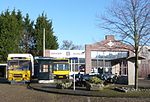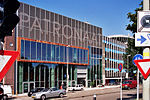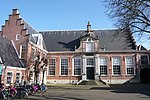Hofje Codde en Van Beresteijn
1598 establishments in EuropeHistory of HaarlemHofjes

The Hofje van Codde en Beresteyn is a hofje in Haarlem, Netherlands. The current building is from 1968 and is located on the J. Cuyperstraat, which is named for the architect who designed the Cathedral of Saint Bavo next door, Joseph Cuypers. This hofje is the wealthiest hofje foundation in Haarlem with the most modern facilities for its inhabitants. Poor (devote) Catholic women of Haarlem 60 years and older are still welcome to live there for free.
Excerpt from the Wikipedia article Hofje Codde en Van Beresteijn (License: CC BY-SA 3.0, Authors, Images).Hofje Codde en Van Beresteijn
Bisschop Bottemanneplein, Haarlem
Geographical coordinates (GPS) Address Nearby Places Show on map
Geographical coordinates (GPS)
| Latitude | Longitude |
|---|---|
| N 52.376666666667 ° | E 4.6211111111111 ° |
Address
Bisschop Bottemanneplein
Bisschop Bottemanneplein
2014 XD Haarlem (Haarlem)
North Holland, Netherlands
Open on Google Maps











